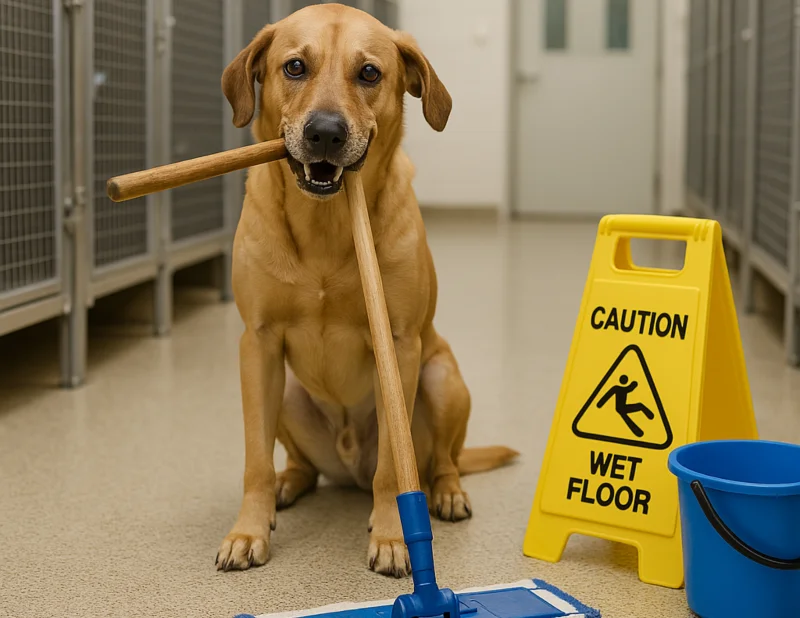As the seasons change and warmer weather approaches, it’s the perfect time for pet care facilities to focus on deep cleaning and sanitation. Maintaining a spotless and safe environment isn’t just about appearance, it’s essential for the well-being of both the animals in your care and your staff. A thorough spring-cleaning routine can help prevent illness, reduce stress for pets, and create a welcoming atmosphere for clients.
Why Spring-Cleaning Matters in Pet Care Facilities
Unlike traditional businesses, pet care facilities handle live animals, making cleanliness a top priority. Hair, dander, bacteria, and potential pathogens can accumulate quickly, leading to health risks for pets and staff. A deep clean helps eliminate hidden dangers and sets the tone for a healthy, efficient operation. Cleanliness also enhances your reputation, reassuring pet owners that their furry companions are in a safe and sanitary environment.
Step-by-Step Guide to Spring Cleaning Your Facility
1. Assess and Plan
Before diving into cleaning, take time to assess the facility. Identify high-traffic areas, surfaces that require deep sanitation, and any equipment needing replacement or repair. Create a checklist to ensure nothing is overlooked. Assign tasks to staff members to streamline the process and make the workload manageable.
2. Sanitize All Surfaces
Disinfecting surfaces should be a daily task, but spring cleaning offers an opportunity to go beyond routine measures. Focus on:
- Kennels, crates, and play areas
- Feeding stations and food storage areas
- Grooming tables and tubs
- Floors, walls, and ventilation systems
- Doorknobs, light switches, and staff break areas Use pet-safe, veterinary-approved disinfectants to kill bacteria and viruses while ensuring animal safety. Steam cleaning can also be an effective, chemical-free method to sanitize surfaces.
3. Deep Clean Bedding & Toys
Pet bedding, blankets, and toys can harbor germs, fur, and dander. Wash all fabric items with hot water and pet-friendly detergent. Inspect toys for signs of wear and replace damaged ones to prevent choking hazards. Consider rotating toys to maintain interest and reduce the buildup of bacteria.
4. HVAC & Ventilation Maintenance
Clean air is vital in a pet care setting. Change HVAC filters, clean vents, and check for any mold or dust buildup. Proper ventilation helps reduce airborne allergens and prevents the spread of illness. If your facility has air purifiers, replace filters as recommended.
5. Floor & Drain Care
Pet care facilities see heavy foot (and paw) traffic, making floors a hotspot for germs. Scrub and disinfect all flooring types, including tile, rubber, and concrete. Ensure drains are clear and use enzymatic cleaners to break down organic matter. Slip-resistant flooring treatments can also enhance safety for both pets and staff.
6. Pest Control Measures
Spring is prime time for fleas, ticks, and other pests. Review your pest control protocol, deep clean storage areas, and ensure there are no food sources attracting unwanted guests. Work with a professional service if needed. Natural deterrents like diatomaceous earth and essential oil sprays can also help keep pests at bay.
7. Organize & Declutter
Over time, clutter can accumulate in storage rooms and offices. Sort through old supplies, expired medications, and outdated paperwork. A well-organized space improves workflow and efficiency. Investing in labeled storage bins can make it easier to locate items quickly.
8. Laundry & Grooming Equipment Maintenance
If your facility offers grooming services, now is a great time to deep clean and inspect equipment. Wash towels, disinfect brushes, and sharpen clipper blades. Ensure dryers and washing machines are in good working condition to handle daily laundry loads efficiently.
9. Safety Check
Use spring cleaning as an opportunity to inspect safety protocols. Test fire extinguishers, check emergency exits, and review staff training on handling pet emergencies. Ensure first-aid kits are fully stocked and accessible. Additionally, evaluate fencing and gates for security, making any necessary repairs.
Maintaining Cleanliness Year-Round
Spring cleaning sets the foundation, but maintaining hygiene and safety should be a continuous effort. Implement daily, weekly, and monthly cleaning schedules to keep the facility in top shape. Regular deep cleans prevent major issues from arising and ensure a safe, happy environment for all. Encourage staff to follow the best practices by providing training on proper cleaning techniques and hygiene protocols.
Eco-Friendly Cleaning Options
For facilities looking to reduce their environmental impact, consider switching to eco-friendly cleaning products. Plant-based disinfectants, reusable cleaning cloths, and water-efficient mopping systems can all contribute to a greener cleaning routine. Additionally, using non-toxic solutions ensures the safety of pets, staff, and the environment.
Final Thoughts
A clean pet care facility isn’t just good practice, it’s a commitment to the animals, staff, and clients who trust you. By taking the time to deep clean, sanitize, and assess safety measures, you create an environment that prioritizes health and professionalism. As you refresh your facility this spring, remember that a little extra effort now leads to a smoother, healthier operation all year long. Keeping up with cleanliness not only protects pets but also boosts client confidence, setting your business apart as a trusted provider in pet care.




